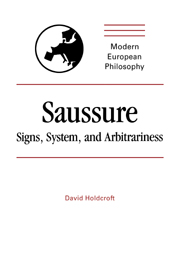Book contents
- Frontmatter
- Contents
- Preface
- Introduction
- 1 Saussure's work: its context and significance
- 2 The distinction between langue and parole
- 3 Language as a system of signs, I: Signs, arbitrariness, linearity, and change
- 4 Language as a system of signs, II: Diachronic and synchronic linguistics
- 5 Language as a system of signs, III: Identities, system, and relations
- 6 Language as a system of signs, IV: Values, differences, and reality
- 7 Successes and failures
- Notes
- Bibliography
- Index
2 - The distinction between langue and parole
Published online by Cambridge University Press: 11 January 2010
- Frontmatter
- Contents
- Preface
- Introduction
- 1 Saussure's work: its context and significance
- 2 The distinction between langue and parole
- 3 Language as a system of signs, I: Signs, arbitrariness, linearity, and change
- 4 Language as a system of signs, II: Diachronic and synchronic linguistics
- 5 Language as a system of signs, III: Identities, system, and relations
- 6 Language as a system of signs, IV: Values, differences, and reality
- 7 Successes and failures
- Notes
- Bibliography
- Index
Summary
As Saussure himself did, I begin the systematic exposition of his views with the distinction between langue and parole. But why begin here? One reason is the unquestionable importance of the distinction for Saussure's system. However, given his overall semiological approach (7.4), the question arises whether the distinction could in fact be derived from some fundamental principles of semiology, in which case it would be natural to begin with them. This is a difficult question, which will be discussed in Chapter 7, where it will be argued that there is no convincing derivation of this kind, so that there is no alternative to treating it as an independent distinction.
The overall aim of Chapter 3 of the Introduction to CLG is to answer the question ‘What is both the integral and concrete object of linguistics?’ (CLG, 23, 7), so a major part of Saussure's interest in drawing the distinction is to enable him to give a precise answer to that question. Moreover, it is clear that the concept of langue plays a crucial role in the answer he gives. What is disputable is not this, but the nature of that role. Is langue itself definitive of the object, so that linguistics is confined to a study of it and nothing else? Or is it that without which we cannot define an object of study, which includes langue of course, but other things as well?
- Type
- Chapter
- Information
- SaussureSigns, System and Arbitrariness, pp. 19 - 46Publisher: Cambridge University PressPrint publication year: 1991



